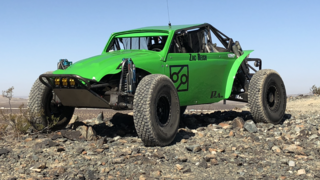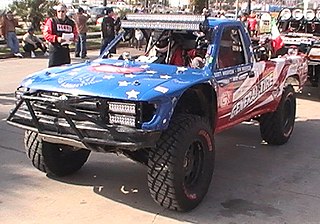
Drag racing is a type of motor racing in which automobiles or motorcycles compete, usually two at a time, to be first to cross a set finish line. The race follows a short, straight course from a standing start over a measured distance, most commonly 1⁄4 mi, with a shorter, 1,000 ft distance becoming increasingly popular, as it has become the standard for Top Fuel dragsters and Funny Cars, where some major bracket races and other sanctioning bodies have adopted it as the standard. The 1⁄8 mi is also popular in some circles. Electronic timing and speed sensing systems have been used to record race results since the 1960s.

Stock car racing is a form of automobile racing run on oval tracks and road courses measuring approximately 0.25 to 2.66 miles. It originally used production-model cars, hence the name "stock car", but is now run using cars specifically built for racing. It originated in the southern United States; its largest governing body is NASCAR. Its NASCAR Cup Series is the premier top-level series of professional stock car racing. Australia, Canada, New Zealand, Mexico, Brazil, Argentina, and the United Kingdom also have forms of stock car racing. Top-level races typically range between 200 and 600 miles in length.

A semi-trailer truck, is the combination of a tractor unit and one or more semi-trailers to carry freight. A semi-trailer attaches to the tractor with a type of hitch called a fifth wheel.

An all-terrain vehicle (ATV), also known as a light utility vehicle (LUV), a quad bike or quad, as defined by the American National Standards Institute (ANSI), is a vehicle that travels on low-pressure tires, has a seat that is straddled by the operator, and has handlebars. As the name implies, it is designed to handle a wider variety of terrain than most other vehicles. It is street-legal in some countries, but not in most states, territories and provinces of Australia, the United States, and Canada.
A World Rally Car is a racing automobile built to the specific regulations set by the Fédération Internationale de l'Automobile (FIA) and designed for competition in the World Rally Championship (WRC). The cars were introduced in 1997 as a replacement for Group A regulations used in the manufacturers' championship, and were replaced by Group Rally1 in 2022.

Front-wheel drive (FWD) is a form of engine and transmission layout used in motor vehicles, in which the engine drives the front wheels only. Most modern front-wheel-drive vehicles feature a transverse engine, rather than the conventional longitudinal engine arrangement generally found in rear-wheel-drive and four-wheel-drive vehicles.
Dirt track racing is a form of motorsport held on clay or dirt surfaced oval race tracks often used for thoroughbred horse racing. Dirt track racing started in the United States before World War I and became widespread during the 1920s and 1930s using both automobiles and motorcycles. Two different types of race cars dominate — open wheel racers in the Northeast and West and stock cars in the Midwest and South. While open wheel race cars are purpose-built racing vehicles, stock cars can be either purpose-built race cars or street vehicles that have been modified to varying degrees. There are hundreds of local and regional racetracks throughout the nation. The sport is also popular in Australia, New Zealand, Canada, South Africa and the United Kingdom.

Pro stock is a class of drag racing featuring "factory hot rods". The class is often described as "all motor", due to the cars not using any form of forced induction such as turbocharging or supercharging, or other enhancements, like nitrous oxide, along with regulations governing the modifications allowed to the engines and the types of bodies used.

A drive wheel is a wheel of a motor vehicle that transmits force, transforming torque into tractive force from the tires to the road, causing the vehicle to move. The powertrain delivers enough torque to the wheel to overcome stationary forces, resulting in the vehicle moving forwards or backwards.

Truck and tractor pulling, also known as power pulling, is a form of a motorsport competition in which antique or modified tractors pull a heavy drag or sled along an 11-meter-wide (35 ft), 100-meter-long (330 ft) track, with the winner being the tractor that pulls the drag the farthest. Tractor pulling is popular in certain areas of the United States, Mexico, Canada, Europe, Australia, Brazil, South Africa, Vietnam, India and New Zealand. The sport is known as the world's most powerful motorsport, due to the multi-engined modified tractor pullers.

A motorized bicycle is a bicycle with an attached motor or engine and transmission used either to power the vehicle unassisted, or to assist with pedalling. Since it sometimes retains both pedals and a discrete connected drive for rider-powered propulsion, the motorized bicycle is in technical terms a true bicycle, albeit a power-assisted one. Typically they are incapable of speeds above 52 km/h (32 mph), however in recent years larger motors have been built, allowing bikes to reach speeds of upwards of 72 km/h.

Championship Off-Road Racing was a sanctioning body for short course off-road racing in the United States. It formed in 1998 and went bankrupt in 2008. Its Midwest races were supplanted in 2007 by the Traxxas TORC Series and by the Lucas Oil Off Road Racing Series on the West Coast in 2009. Both received most of the drivers and adopted the same racing format.
Pro FWD is a class in drag racing. The E.T. Bracket categories are no-electronics classes. Delay devices, throttle stops, air shifters, transbrakes, etc. or any device that transmits real-time, on-track data to the driver or any remote location are prohibited. All applicable NHRA rules apply based on elapsed time.
Class 1 Touring Cars refers to two generations of prototype silhouette-style touring car regulations employed by the FIA.

SCOREClass Stock Mini is a stock production class that competes in the SCORE off-road race series including the Baja 1000, Baja 500, Baja Sur 500, San Felipe 250 and the SCORE Desert Challenge.

SCOREClass 11 is a stock production Volkswagen Beetle class that competes in the SCORE off-road race series, including the Baja 1000, Baja 500, Baja Sur 500, San Felipe 250 and the SCORE Desert Challenge. Class 11 is the most grueling of all off-road race vehicles as they are pure stock with modifications limited to only safety reinforcement and ground clearance. Class 11 repeat champion Eric Solórzano was featured in Dust to Glory, a documentary on the 2003 Baja 1000.
SCOREClass 2 is an unlimited four wheel single & two-seat vehicle class. The maximum engine size is a 3.5 liter, six cylinder forced air induction engine. Engines must have no more than six cylinders but forced induction is open to both turbo and superchargers. The minimum weight is 2,000 pounds.

SCORE Class 5 is described as "open wheel unlimited Baja Bug class that competes in the SCORE off-road race series races including the Baja 1000, Baja 500, San Felipe 250, Baja Sur 500 and the SCORE Desert Challenge.

SCOREClass 7SX is a stock production Mini Pickup class that competes in the SCORE off-road race series races including the Baja 1000, Baja 500, Baja Sur 500, San Felipe 250, and the SCORE Desert Challenge.

The NASCAR Cup Series is the top racing series of the National Association for Stock Car Auto Racing (NASCAR). The series began in 1949 as the Strictly Stock Division, and from 1950 to 1970 it was known as the Grand National Division. In 1971, when the series began leasing its naming rights to the R. J. Reynolds Tobacco Company, it was referred to as the NASCAR Winston Cup Series (1971–2003). A similar deal was made with Nextel in 2003, and it became the NASCAR Nextel Cup Series (2004–2007). Sprint acquired Nextel in 2005, and in 2008 the series was renamed the NASCAR Sprint Cup Series (2008–2016). In December 2016, it was announced that Monster Energy would become the new title sponsor, and the series was renamed the Monster Energy NASCAR Cup Series (2017–2019). In 2019, NASCAR rejected Monster's offer to extend the naming rights deal beyond the end of the season. NASCAR subsequently announced its move to a new tiered sponsorship model beginning with the 2020 season similar to other U.S. based professional sports leagues, where it was simply known as the NASCAR Cup Series, with the sponsors of the series being called Premier Partners. The four Premier Partners are Busch Beer, Coca-Cola, GEICO, and Xfinity.














